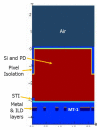Automotive 3.0 µm Pixel High Dynamic Range Sensor with LED Flicker Mitigation
- PMID: 32143277
- PMCID: PMC7085572
- DOI: 10.3390/s20051390
Automotive 3.0 µm Pixel High Dynamic Range Sensor with LED Flicker Mitigation
Abstract
We present and discuss parameters of a high dynamic range (HDR) image sensor with LED flicker mitigation (LFM) operating in automotive temperature range. The total SNR (SNR including dark fixed pattern noise), of the sensor is degraded by floating diffusion (FD) dark current (DC) and dark signal non-uniformity (DSNU). We present results of FD DC and DSNU reduction, to provide required SNR versus signal level at temperatures up to 120 °C. Additionally we discuss temperature dependencies of quantum efficiency (QE), sensitivity, color effects, and other pixel parameters for backside illuminated image sensors. Comparing +120 °C junction vs. room temperature, in visual range we measured a few relative percent increase, while in 940 nm band range we measured 1.46x increase in sensitivity. Measured change of sensitivity for visual bands-such as blue, green, and red colors-reflected some impact to captured image color accuracy that created slight image color tint at high temperature. The tint is, however, hard to detect visually and may be removed by auto white balancing and temperature adjusted color correction matrixes.
Keywords: CMOS; LED flicker mitigation; automotive; high dynamic range; image sensor; quantum efficiency; sensitivity; temperature dependence.
Conflict of interest statement
The authors declare no conflict of interest.
Figures

























References
-
- Silsby C., Velichko S., Johnson S., Lim Y.P., Mentzer R., Beck J. A 1.2MP 1/3 CMOS Image Sensor with Light Flicker Mitigation; Proceedings of the IISW 2015; Vaals, The Netherlands. 8–11 June 2015.
-
- Velichko S., Johnson S., Pates D., Silsby C., Hoekstra C., Mentzer R., Beck J. 140dB Dynamic Range Sub-electron Noise Floor Image Sensor; Proceedings of the IISW 2017; Hiroshima, Japan. 30 May–2 June 2015.
-
- Iida S., Sakano Y., Asatsuma T., Takami M., Yoshiba I., Ohba N., Mizuno H., Oka T., Yamaguchi K., Suzuki A., et al. A 0.68e-rms random-noise 121dB dynamic-range sub-pixel architecture CMOS image sensor with LED flicker mitigation; Proceedings of the 2018 IEEE International Electron Devices Meeting (IEDM); San Francisco, CA, USA. 1–5 December 2018; pp. 221–224.
-
- Yu J., Collins D.J., Yasan A., Bae S., Ramaswami S. Hot Pixel reduction in CMOS image Sensor Pixels; Proceedings of the IS&T/SPIE Electronic Imaging; San Jose, CA, USA. 17–21 January 2010;
LinkOut - more resources
Full Text Sources

